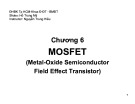JOURNAL OF SCIENCE AND TECHNOLOGY DONG NAI TECHNOLOGY UNIVERSITY
26
Special Issue
EFFECTIVE STRATEGIES FOR EFFICIENT EXCIPLEX EMISSION IN ORGANIC LIGHT-EMITTING DIODES
Pham Van Thanh*
Dong Nai Technology University *Corresponding author: Pham Van Thanh, phamvanthanh@dntu.edu.vn
GENERAL INFORMATION
Received date: 13/03/2024
Revised date: 16/05/2024
Accepted date: 04/07/2024
KEYWORD
material
combinations.
OLEDs;
Exciplex emission;
characteristics
Organic electronics;
Energy band gap;
Importantly, we emphasize
Material combinations.
ABSTRACT This paper presents a comprehensive investigation into the optimization of exciplex emission in organic light-emitting diodes (OLEDs). Through a systematic exploration of various combinations of hole-transporting materials (HTMs) and electron-transporting materials (ETMs), we elucidate critical factors influencing exciplex formation and its impact on OLED performance. Our analysis focuses on estimating the energy band gap of exciplexes, guiding the selection of appropriate Experimental observations reveal distinct exciplex emission profiles and different HTM/ETM for lifetime combinations, providing valuable insights into exciplex formation dynamics. the significance of ensuring that the HTM/ETM combination possesses a higher triplet energy bandgap than the exciplex to optimize OLED performance and enhance energy efficiency. Overall, this study contributes to the advancement of OLED technology by offering effective strategies for achieving efficient exciplex emission, with implications for lighting, displays, and other applications
through 1. INTRODUCTION
diodes light-emitting
the capture of
In recent years, significant strides have been made in the development of efficient organic (OLEDs) through the utilization of two innovative techniques: exciplex and thermally-activated delayed fluorescence (TADF). A crucial aspect of TADF lies in the requirement of a minimal energy band gap between the first triplet excited state and the first singlet excited state (ΔEST), facilitating triplet excitons through reverse intersystem crossing. Similarly, achieving a small ΔEST is also pivotal in the exciplex technique, wherein it is generated through-space intermolecular charge transfer between a hole- transporting material (HTM) and an electron- transporting material (ETM). What's noteworthy is that exciplex formation can be readily induced using commercially available materials. Generally, an exciplex can be created either through a bilayer structure employing both HTM and ETM, or by directly blending an HTM with an ETM. The latter method typically yields higher exciplex production rates. In principle, the energy band gap of an exciplex is dictated by the energy- level difference, implying that it could be tailored by selecting appropriate materials (Hu
27
Special Issue
JOURNAL OF SCIENCE AND TECHNOLOGY DONG NAI TECHNOLOGY UNIVERSITY
mass spectrometry, and elemental analysis to confirm their structures and purity.
into
et al., 2020). Nevertheless, effective systems for achieving efficient exciplex emission remain somewhat scarce even to this day. Therefore, the focus of this study is to delve the exploration of effective deeper systems for achieving efficient exciplex emission in OLEDs (Ying et al., 2022).
thermal by
theoretical followed by (EML), layer
Device fabrication: OLED devices were fabricated using a standard procedure. Indium tin oxide (ITO)-coated glass substrates were cleaned, followed by deposition of a hole injection layer (HIL) and a hole transport layer (HTL) evaporation. The HTM/ETM mixture was deposited as the the emissive deposition of an electron transport layer (ETL) and a cathode. The devices were encapsulated to prevent degradation.
and molecular
Our approach involves a multifaceted investigation encompassing both experimental methodologies. and Experimentally, we intend to synthesize and meticulously characterize various HTMs and ETMs, taking into account critical material properties such as electron affinity, ionization potential, architecture. Subsequently, we plan to fabricate OLED devices employing these materials, either in bilayer configurations or through direct blending, to facilitate exciplex formation (Wang et al., 2021; Zhang et al., 2021).
recorded
as and
Characterization of OLED devices: The fabricated OLED devices were characterized using various techniques. Current-voltage- (IVL) measurements were luminance performed to assess the electrical properties, including current density, luminance, and efficiency. Photoluminescence (PL) spectra were the emission to analyze characteristics of the devices. Time-resolved measurements, transient such transient photoluminescence electroluminescence, were conducted to study the exciton dynamics and device kinetics.
and Exciplex formation
a wide array
conducted
characterized technologies,
We will harness the power of theoretical modeling and computational simulations to forecast the energy level alignment and charge transfer dynamics between HTMs and ETMs (Chi et al., 2022). This computational insight will serve as a guiding principle in the rational design of material combinations with favorable exciplex properties. By meticulously exploring of material combinations and device architectures, we aim to unravel the key determinants that augment exciplex emission efficiency in OLEDs. Ultimately, our findings hold the promise of catalyzing the advancement of next-generation by OLED enhanced performance and energy efficiency (Vipin et al., 2021). lifetime in the measurements: Exciplex formation through OLED devices was investigated photoluminescence measurements under different excitation conditions. Time-resolved PL measurements were to determine the excited-state lifetimes of the devices. The exciplex emission profiles and decay kinetics were analyzed to elucidate the mechanisms governing exciplex formation and emission. 2. EXPERIMENT
charge alignment
materials) to according
Material synthesis and characterization: HTMs (hole-transporting materials) and ETMs were (electron-transporting synthesized established procedures. The materials were characterized using various techniques such as nuclear (NMR) spectroscopy, magnetic resonance Computational modeling: The energy level transfer and characteristics between HTMs and ETMs were theoretically modeled using computational methods. Density functional theory (DFT) calculations dynamics and molecular simulations were employed to predict the intermolecular electronic structure and
28
Special Issue
JOURNAL OF SCIENCE AND TECHNOLOGY DONG NAI TECHNOLOGY UNIVERSITY
measurements, indicating both prompt and delayed emissions, while sample B exhibited only a nanosecond-scale component. understanding the of interactions of the materials. Theoretical insights were compared with experimental data to validate the findings and provide a deeper exciplex formation process.
than 3. RESULTS AND DISCUSSION
(∆EST ~ 0.1 is pivotal in predicting
the the
As depicted in Figure 3(a), uncovered that both TCTA and BP4mPy possessed lower the TCTA: triplet energy bandgaps BP4mPy mixture (sample B). This minimal energy difference eV) corroborated the exciplex emission origin. phosphorescence Furthermore, measurements (Figure 3(b)) unveiled a gradual decay in exciplex emission with extended times, accompanied by additional delay emissions BP4mPy's resembling phosphorescence. This observation provided concrete evidence of exothermic energy transfer.
our photophysical estimated
insights Understanding the energy band gap of exciplexes their emission characteristics, as it relies on the energy difference between lowest unoccupied molecular orbital (LUMO) of the electron-transporting material (ETM) and the highest occupied molecular orbital (HOMO) of the hole-transporting material (HTM). This relationship offers a rough estimate of the exciplex's emission color based on their from levels. Drawing respective energy previous literature, the LUMOs of BP4mPy, TmPyPB, and B3PyMPM were approximated to be around 2.57 eV, 2.73 eV, and 3.20 eV, respectively. Likewise, the HOMOs of TCTA and m-MTDATA were at approximately 5.80 eV and 5.10 eV. Calculating the LUMO/HOMO differences yielded values of 4.09 eV for TCTA: BP4mPy, 2.37 eV for m-MTDATA: TmPyPB, and 1.90 eV for m-MTDATA: B3PyMPM.
Our findings underscore the significance of judiciously selecting HTM/ETM combinations to attain red, green, and blue emissions. Additionally, results emphasize the necessity of ensuring that the HTM/ETM combination possesses a higher triplet energy bandgap than the exciplex to minimize energy loss to individual molecules. This study offers valuable into optimizing OLED performance through effective exciplex formation, paving the way for advancements in organic electronics. to
We selected three combinations of HTM and ETM formation. foster exciplex Specifically, TCTA and m-MTDATA served as the HTMs, while BP4mPy, TmPyPB, and B3PyMPM were chosen as the corresponding ETMs. These combinations were represented by samples labeled as B, G, and R, with their respective chemical structures and schematic energy level diagrams illustrated in Figure 1.
and spectra excited-state
The analysis of the photoluminescence lifetime (PL) measurements of the thin-film samples, as presented in Figure 2, revealed intriguing differences. Sample B exhibited a narrower spectrum compared to samples G and R, suggesting a distinct exciplex emission profile. Moreover, samples G and R displayed a two- lifetime component decay their in
29
Special Issue
JOURNAL OF SCIENCE AND TECHNOLOGY DONG NAI TECHNOLOGY UNIVERSITY
Figure 1. (a) Chemical structures of the materials; (b) the schematic energy level diagram.
Figure 3. (a) The fluorescent and phosphorescent spectra of TCTA, BP4mPy, and sample B. (b) The phosphorescent spectra of sample B with different delay times. (c) The schematic diagram of energy tranfers in sample B and R
4. CONCLUSION
Figure 2. (a) The PL Spectra of sample A, B and C. (b). The decay characteristics of sample A,B and C
Our study into efficient exciplex emission in OLEDs has shed light on critical factors influencing their performance. By examining various combinations of hole-transporting materials (HTMs) and electron-transporting materials (ETMs), we have gained valuable insights into exciplex formation and its impact on OLED characteristics.
the The experiment results highlight importance of understanding the energy band gap of exciplexes, which is determined by the energy difference between the LUMO of the ETM and the HOMO of the HTM. This
30
Special Issue
JOURNAL OF SCIENCE AND TECHNOLOGY DONG NAI TECHNOLOGY UNIVERSITY
8(7),
Emission. Advanced Near‐Infrared 1901917. Optical Materials, https://doi.org/10.1002/adom.201901917 understanding allowed us to estimate the emission color of exciplexes and select appropriate material combinations for our study.
Through
lifetime characteristics
exciplex about analysis, we experimental observed distinct exciplex emission profiles and for different HTM/ETM combinations. Samples exhibited a range of emission behaviors, including prompt and delayed emissions, providing valuable information formation dynamics.
Vipin, C. K., Shukla, A., Rajeev, K., Hasan, M., Lo, S.-C., Namdas, E. B., Ajayaghosh, A., & Unni, K. N. N. (2021). White Organic Light-Emitting Diodes from Single Emissive Layers: Combining Exciplex Emission with Electromer Emission. The Journal of Physical Chemistry C, 125(41), 22809– 22816. https://doi.org/10.1021/acs.jpcc.1c06323
Our findings underscored the significance of ensuring that the HTM/ETM combination possesses a higher triplet energy bandgap than the exciplex to minimize energy loss to individual molecules. This insight is crucial for optimizing OLED performance and enhancing energy efficiency. The paper contributes to the advancement of OLED technology by elucidating effective strategies for achieving efficient exciplex emission. By leveraging the principles of exciplex formation and energy transfer, future OLED designs can be tailored to exhibit improved performance and color purity, paving the way for innovative applications in lighting, displays, and beyond.
Wang, X.-Q., Hu, Y., Yu, Y.-J., Tian, Q.-S., Shen, W.-S., Yang, W.-Y., Jiang, Z.-Q., & Liao, L.-S. (2021). Over 800 nm Emission via Harvesting of Triplet Excitons in Exciplex Organic Light- Journal of Emitting Diodes. The Physical Chemistry Letters, 12(26), 6034–6040. https://doi.org/10.1021/acs.jpclett.1c016 09
REFERENCES
105,
Chi, J., Chen, L., Qiao, X., Xiao, S., Guo, X., & Ma, D. (2022). Visualizing the exciton formation channel in exciplex-based organic light-emitting diodes. Organic 106497. Electronics, https://doi.org/10.1016/j.orgel.2022.1064 97
Ying, S., Xiao, S., Peng, L., Sun, Q., Dai, Y., Qiao, X., Yang, D., Chen, J., & Ma, D. (2022). Exciton Regulation for Organic Light-Emitting Diodes with Improved Efficiency and Roll-Off by Managing the Bipolar Spacer Layers Based on Interfacial Exciplexes. ACS Applied Electronic Materials, 4(6), 3088–3098. https://doi.org/10.1021/acsaelm.2c00483 Exciplex‐Based
(2020). Light‐Emitting Diodes
Materials Horizons, 8(2), 401–425. https://doi.org/10.1039/D0MH01245A
Hu, Y., Yu, Y., Yuan, Y., Jiang, Z., & Liao, L. Organic with Zhang, M., Zheng, C.-J., Lin, H., & Tao, S.-L. (2021). Thermally activated delayed fluorescence exciplex emitters for high- performance organic light-emitting diodes.
















![Ô nhiễm không khí từ nông nghiệp: Thách thức toàn cầu và định hướng hành động [Mới nhất]](https://cdn.tailieu.vn/images/document/thumbnail/2025/20250917/kimphuong1001/135x160/52891758099584.jpg)









